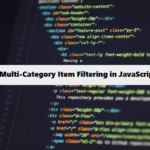You can remove a specific item from an array in JavaScript using various methods. Here are a few common approaches:
1. Using filter()
- Description: The
filter()method creates a new array with all elements that pass the test implemented by the provided function. It does not modify the original array. - How it works: You provide a callback function that returns
truefor elements you want to keep andfalsefor those you want to remove. - Example:
#javascript
const array = [1, 2, 3, 4, 5];
const itemToRemove = 3;
const newArray = array.filter(item => item !== itemToRemove);
console.log(newArray); // Output: [1, 2, 4, 5]
- Pros: Simple and readable; does not mutate the original array.
- Cons: Creates a new array, which may not be efficient for large datasets if mutability is not a concern.
2. Using splice()
- Description: The
splice()method changes the contents of an array by removing or replacing existing elements and/or adding new elements in place. - How it works: You first find the index of the item you want to remove using
indexOf(). If the item exists, you callsplice(index, 1)to remove one element at that index. - Example:
#javascript
const array = [1, 2, 3, 4, 5];
const itemToRemove = 3;
const index = array.indexOf(itemToRemove);
if (index !== -1) {
array.splice(index, 1); // Removes 3 from the array
}
console.log(array); // Output: [1, 2, 4, 5]
- Pros: Efficient for modifying the original array; can remove items by index.
- Cons: Mutates the original array, which may not be desirable in all situations.
3. Using forEach() with splice()
- Description: This approach involves looping through the array and using
splice()to remove items. - How it works: As you loop through the array, if you find an item that matches the one you want to remove, you call
splice()to remove it. - Example:
#javascript
const array = [1, 2, 3, 2, 4, 5];
const itemToRemove = 2;
array.forEach((item, index) => {
if (item === itemToRemove) {
array.splice(index, 1); // Remove item at index
}
});
console.log(array); // Output: [1, 3, 4, 5]
- Pros: Allows for removal of all occurrences of an item.
- Cons: Mutates the array and can lead to unexpected behavior if the array is modified while iterating through it.
4. Using reduce()
- Description: The
reduce()method executes a reducer function on each element of the array, resulting in a single output value (in this case, a new array). - How it works: You can accumulate values in a new array while skipping the item you want to remove.
- Example:
#javascript
const array = [1, 2, 3, 4, 5];
const itemToRemove = 3;
const newArray = array.reduce((acc, item) => {
if (item !== itemToRemove) {
acc.push(item); // Add to the accumulator if not the item to remove
}
return acc;
}, []);
console.log(newArray); // Output: [1, 2, 4, 5]
- Pros: Functional programming style, creates a new array without modifying the original.
- Cons: Slightly more complex syntax; can be less readable than other methods for simple removal tasks.
Note:
The choice of method depends on your specific use case, such as whether you want to mutate the original array or create a new one, and whether you need to remove one or multiple occurrences of an item. Each method has its pros and cons, so consider performance and readability when making your selection.
Understanding How Coding Filters Help Reduce Complexity!
Coding filters offer a powerful way to reduce complexity by providing a mechanism to focus on relevant data or logic while ignoring unnecessary elements. By applying these filters, developers can avoid convoluted conditional statements, reducing code length and enhancing clarity in their applications.




